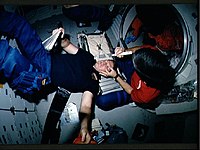
Photo from wikipedia
Spaceflight associated neuro-ocular syndrome (SANS), a health risk related to long-duration spaceflight, is hypothesized to result from a headward fluid shift that occurs with the loss of hydrostatic pressure gradients… Click to show full abstract
Spaceflight associated neuro-ocular syndrome (SANS), a health risk related to long-duration spaceflight, is hypothesized to result from a headward fluid shift that occurs with the loss of hydrostatic pressure gradients in weightlessness. Shifts in the vascular and cerebrospinal fluid compartments alter the mechanical forces at the posterior eye and lead to flattening of the posterior ocular globe. The goal of the present study was to develop a method to quantify globe flattening observed by magnetic resonance imaging after spaceflight. Volumetric displacement of the posterior globe was quantified in 10 astronauts at 5 time points after spaceflight missions of ~6 months. Mean globe volumetric displacement was 9.88 mm3 (95% CI 4.56–15.19 mm3, p < 0.001) on the first day of assessment after the mission (R[return]+ 1 day); 9.00 mm3 (95% CI 3.73–14.27 mm3, p = 0.001) at R + 30 days; 6.53 mm3 (95% CI 1.24–11.83 mm3, p < 0.05) at R + 90 days; 4.45 mm3 (95% CI −0.96 to 9.86 mm3, p = 0.12) at R + 180 days; and 7.21 mm3 (95% CI 1.82–12.60 mm3, p < 0.01) at R + 360 days. There was a consistent inward displacement of the globe at the optic nerve, which had only partially resolved 1 year after landing. More pronounced globe flattening has been observed in previous studies of astronauts; however, those observations lacked quantitative measures and were subjective in nature. The novel automated method described here allows for detailed quantification of structural changes in the posterior globe that may lead to an improved understanding of SANS.
Journal Title: Eye
Year Published: 2021
Link to full text (if available)
Share on Social Media: Sign Up to like & get
recommendations!